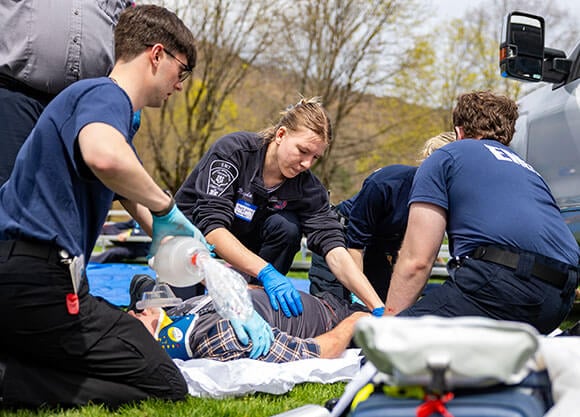
Training exercise offers Quinnipiac EMS opportunity to learn with area first responders
April 24, 2024

April 24, 2024

The hands-on scenario in a corner of the Mount Carmel Campus was strewn with volunteers enacting roles of victims and bystanders with realistic-looking injuries, wounds, and psychological impacts after a fictious driver under the influence "crashed" a pickup into a crowded sporting event. In two different evolutions, the patient-focused drill unfolded in real time from the point of contact to the first arriving crew and the final simulated transfer of patients to definitive care.
Quinnipiac EMS Captain Alex Bayer BSN ’25, said his team organized the drill with the goal of testing the ability for internal responders to effectively plan and work with outside agencies on the forward movement of patients should such an incident arise, and to help identify any strains on the local 911 system.
“If there were to be a real mass casualty incident to occur on campus, we’d call upon our local community resources and neighboring departments,” said Bayer. “So we invited them today to come out to our campus and see how we work, and to see what it might look like.”
In addition to Quinnipiac EMS and Quinnipiac Public Safety, event supporters included Hartford HealthCare, Yale New Haven Health, Gateway Business Communications Inc., American Medical Response Inc., Trinity Health, and Hunter’s Ambulance. Additional agencies participating in the drill included CESI at Hartford Hospital; North Branford Fire Department, Bethany Fire Department, Old Saybrook Fire Department, and Hamden Fire Department.
Hamden Fire Department Captain and Training Officer Julio Lopes said the department was there to support the Quinnipiac EMS drill as a close community partner of the university.
“They’ve done a great job with their program initially starting it a few years ago to where it is now. It’s been a great way to have students involved in the process that are going into the EMS field,” said Lopes of Quinnipiac EMS, which became a state-certified supplemental first responder agency in 2018.
“This is going to help them to get a better, broader understanding of the EMS structure and what we do in a mass casualty situation and how all the partners come together to care for victims,” said Lopes. “It’s also a great opportunity to bring all these programs together and to practice working seamlessly and to make adjustments so when an incident does happen, everybody understands their responsibilities and their role.”
Hunter’s Ambulance EMS Education and Training Supervisor Scott Marotto, who is also a member of the Quinnipiac EMS board, said the drill had multifaceted implications for professionals and students.
“It allows us to coordinate with different agencies and departments that might work a little differently, to better align our treatment, our processes and our priorities and it gives our students and observers an inside look at what it’s really like, but in a controlled environment; so it puts them through those stress responses without any immediate impact,” said Marotto.
The event also extended an educational opportunity to EMS providers by offering a morning didactic session with medical or leadership tracks. Emergency Medical Technician (EMT) students were also encouraged to participate in the morning medical session, as well as to observe the afternoon drill evolutions.
Quinnipiac EMS members Abby Crowell ’25, a nursing major; and Lia Roybal ’25, a biomedical sciences major, wrote the 40 different victim, bystander, and patient roles for the drill. Volunteers filling the roles included Quinnipiac students and the Frank H. Netter MD School of Medicine Standardized Patient Assessment Center actors.
Quinnipiac EMS member Emina Metjahic ’24, a behavioral neuroscience major, volunteered as an actor for the drill in order to experience the other side of her work as a first responder.
“I’ve always been in an EMT and provider role, and I thought it would be interesting to know from the other hand how we react in these situations and what it feels like from a patient’s perspective,” said Metjahic. “Everything I know is from a healthcare perspective, and I think it’s important to also know how it feels to be in this situation.”
School of Health Sciences Dean Janelle Chiasera said the event provided several unique opportunities for learning at many levels.
“This is the first time we’ve been able to do this, where we have partnered with our community agencies to create a safer community, and so that our students can learn from the communities, and the communities can learn from us,” said Chiasera.
Quinnipiac Today is your source for what's happening throughout #BobcatNation. Sign up for our weekly email newsletter to be among the first to know about news, events and members of our Bobcat family who are making a positive difference in our world.
Sign Up Now